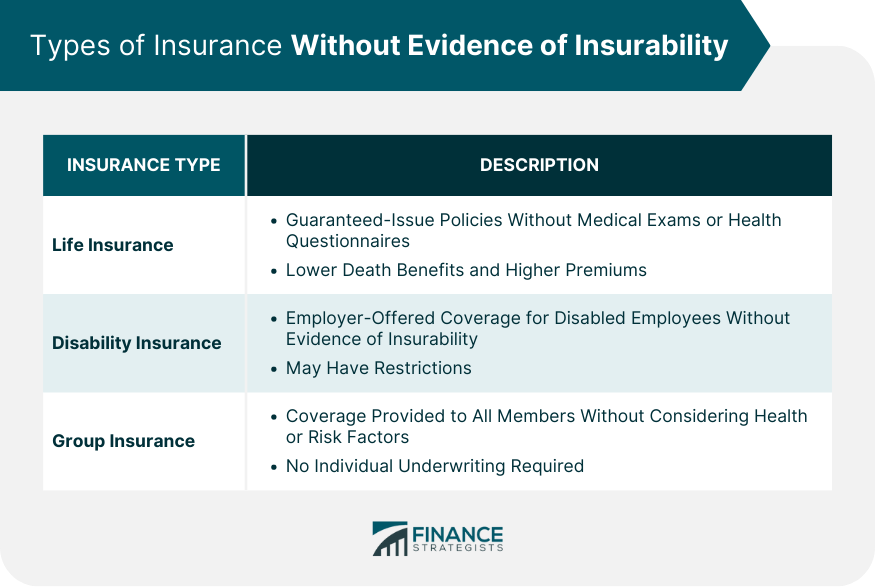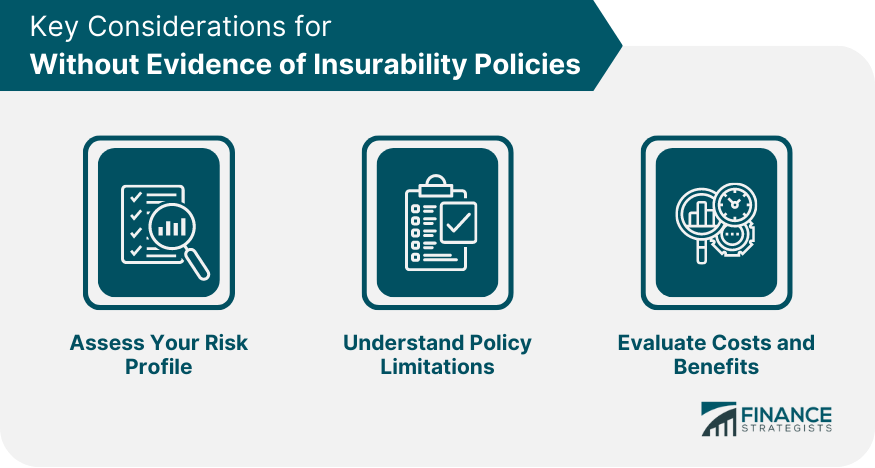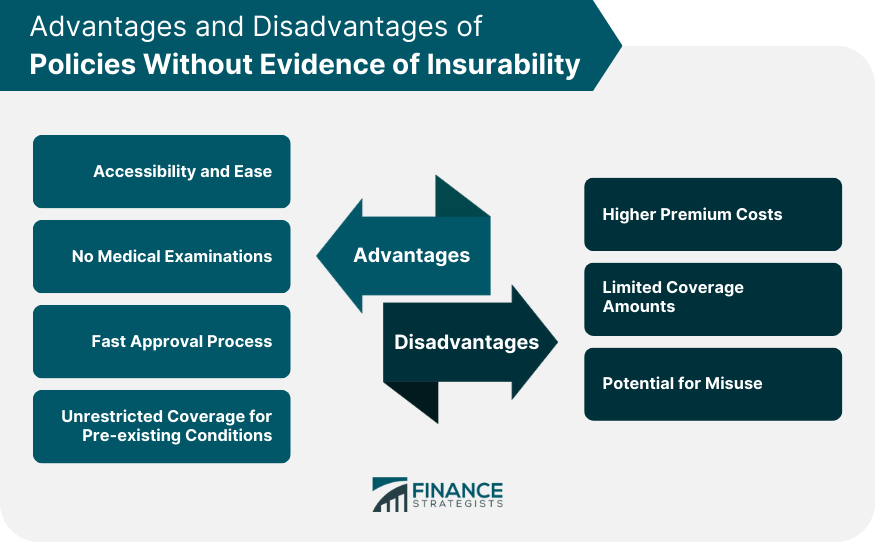'Without evidence of insurability' is a term used in the insurance industry to denote policies that are issued without the typical underwriting process. Unlike standard insurance policies, these do not require an evaluation of the applicant's health, lifestyle, or occupational risks, making them attractive to those who might struggle to secure coverage otherwise. In the context of insurance, 'evidence of insurability' involves detailed information, such as medical history, occupation, and lifestyle, which helps insurers ascertain an individual's risk level. This assessment of risk is crucial as it directly influences premium costs and the decision to grant coverage. A high-risk individual may face higher premiums or even be declined coverage. Insurability allows companies to balance risk and reward, pricing their products in a way that maintains their profitability and capability to cover potential claims. This delicate balance helps in upholding consumer affordability and sustaining the insurance business model. Policies without evidence of insurability are often applicable in group insurance plans, such as those provided by employers, where the risk is spread across a large number of individuals. These policies are also beneficial for older individuals or those with pre-existing conditions who might struggle to get coverage through traditional means. Some insurers also offer individual policies without evidence of insurability, typically termed as 'guaranteed issue' policies, though these often come with higher premiums and lower coverage amounts. There are several types of insurance that often come without evidence of insurability requirements. Guaranteed-issue life insurance is a type of policy that doesn't require medical examinations or health questionnaires. As the name suggests, the policy is 'guaranteed' – as long as you pay your premiums, the insurer will provide the coverage. However, these policies usually offer lower death benefits and higher premiums compared to standard life insurance policies. Some disability insurance policies also come without evidence of insurability. These policies are typically offered through employers and cover a percentage of the employee's income if they become disabled and cannot work. Like guaranteed issue life insurance, these policies might come with certain restrictions and limitations. Group insurance policies, commonly provided by employers, professional organizations, or unions, are perhaps the most common type of insurance without evidence of insurability. These policies offer coverage to all members of the group, regardless of individual health status or other risk factors. The risk is spread across the group, allowing the insurer to offer coverage without individual underwriting. While policies without evidence of insurability can offer much-needed coverage for those who might otherwise struggle to get insured, it's essential to consider several factors before purchasing these policies. Your risk profile, including factors such as age, health status, lifestyle, and occupation, impacts how desirable or necessary a policy without evidence of insurability is for you. If you're young, healthy, and work in a low-risk occupation, you might find better rates and coverage options with traditional insurance policies. Conversely, if you're older, have health issues, or work in a high-risk job, a policy without evidence of insurability might be more beneficial. Policies without evidence of insurability often come with limitations. These might include lower coverage amounts, waiting periods before coverage begins, and higher premiums. It's crucial to understand these limitations before purchasing a policy. Ultimately, choosing an insurance policy is a matter of weighing the costs against the benefits. While policies without evidence of insurability offer guaranteed coverage, they often come at a higher cost. However, for many, the benefit of guaranteed coverage outweighs the higher costs. It's important to evaluate your personal situation, consider your needs and financial circumstances, and make the decision that best suits your individual needs. One of the primary advantages of these policies is their accessibility. They're available to almost anyone, regardless of health status, age, or occupation. This makes them a viable option for those who might not qualify for traditional insurance policies. Their application process is also typically straightforward and less time-consuming than conventional insurance applications. Policies without evidence of insurability eliminate the need for medical examinations, which can be a significant advantage for those with chronic health conditions or older individuals who might not otherwise qualify for insurance coverage. Without the need to review medical records or conduct detailed risk assessments, insurers can approve these policies much more quickly than traditional policies. This expedited process can be a major benefit for individuals who need coverage quickly. Unlike many traditional insurance policies, policies without evidence of insurability usually do not exclude coverage for pre-existing conditions, providing a safety net for individuals with such health concerns. Despite the benefits, there are several potential downsides to consider when evaluating policies without evidence of insurability. As these policies pose more risk for insurers, they often come with higher premium costs compared to traditional insurance policies. The amount of coverage available is usually lower than what could be obtained through a standard policy. For life insurance, this might mean a smaller death benefit. For disability insurance, it could translate to a lower percentage of income coverage. The ease of obtaining these policies can sometimes lead to misuse, with individuals purchasing policies with no intention of using them responsibly. This can contribute to higher premiums for everyone in the risk pool. John, a 65-year-old smoker with a history of heart disease, struggled to find an insurer willing to offer him a traditional life insurance policy. He opted for a guaranteed issue life insurance policy, which didn't require a medical examination or any health-related questions. Although the policy had a lower death benefit and higher premiums than a standard policy, it provided John with the coverage he needed. Sarah started a new job and was offered group health insurance as part of her employment benefits. Regardless of her medical history, she was automatically eligible for the coverage. The premiums were deducted from her paycheck, providing her with an easy and convenient insurance solution. Brian, a 40-year-old with a hectic schedule, wanted life insurance but didn't have time for medical exams or a lengthy approval process. He selected a no-medical exam life insurance policy, which offered him quick coverage with slightly higher premiums. Like all insurance policies, those without evidence of insurability are subject to regulatory oversight to protect consumers and maintain the integrity of the insurance industry. To protect consumers, insurance regulations often mandate clear communication about policy terms, including any limitations or exclusions. Some jurisdictions may also have rules around the pricing of these policies to prevent excessive premiums. Insurance companies are required to maintain certain financial standards to ensure they can meet their policy obligations. This includes maintaining adequate reserves to pay claims, even when they offer policies without evidence of insurability. Insurance commissioners or similar regulatory bodies oversees the insurance industry, ensuring companies adhere to all regulations. They handle consumer complaints, conduct audits, and can levy penalties against companies that violate rules. This regulatory oversight helps maintain consumer confidence in policies without evidence of insurability. 'Without evidence of insurability' is a term used in insurance to describe policies issued without requiring evidence like medical exams or lifestyle evaluations, essentially providing coverage regardless of individual risk factors. This insurance type offers significant advantages, including accessibility and ease, quick approval, no requirement for medical examinations, and coverage for pre-existing conditions. However, these policies also present potential drawbacks like higher premiums, limited coverage amounts, and a potential for misuse. Weighing the pros and cons, consumers should consider their risk profile, understand the limitations of these policies, and evaluate the costs versus benefits. Regardless of your personal circumstances, remember that insurance plays a pivotal role in a well-rounded financial plan. Before making a decision, consider consulting with an insurance broker. A seasoned broker can offer personalized advice, guiding you through the maze of insurance products to find the one that suits your needs and circumstances.What Is Without Evidence of Insurability?
Circumstances When 'Without Evidence of Insurability' is Applicable
Types of Insurance Without Evidence of Insurability
Life Insurance
Disability Insurance
Group Insurance

Key Considerations for Without Evidence of Insurability Policies
Assess Your Risk Profile
Understand Policy Limitations
Evaluate Costs and Benefits

Advantages of Policies Without Evidence of Insurability
Accessibility and Ease
No Medical Examinations
Fast Approval Process
Unrestricted Coverage for Pre-existing Conditions
Disadvantages of Policies Without Evidence of Insurability
Higher Premium Costs
Limited Coverage Amounts
Potential for Misuse

Case Studies of Policies Without Evidence of Insurability
Guaranteed Issue Life Insurance
Employer-Provided Group Insurance
No Medical Exam Life Insurance
Regulatory Aspects of Policies Without Evidence of Insurability
Consumer Protection Regulations
Industry Regulations and Standards
Role of Insurance Commissioners
Final Thoughts
Without Evidence of Insurability FAQs
'Without evidence of insurability' refers to insurance policies that are issued without the need for an individual to prove their insurability through medical exams or lifestyle and occupational questionnaires.
Policies without evidence of insurability can be particularly beneficial for older individuals, those with pre-existing health conditions, or individuals with high-risk occupations who might struggle to obtain traditional insurance.
Life insurance, disability insurance, and group insurance are common types of insurance that can be obtained without evidence of insurability.
While these policies offer guaranteed coverage, they often come with higher premium costs and lower coverage amounts. They might also have certain restrictions and limitations.
Regulations protect consumers by ensuring clear communication about policy terms and pricing. Regulatory bodies oversee insurance companies to ensure they maintain financial standards and can meet their policy obligations.
True Tamplin is a published author, public speaker, CEO of UpDigital, and founder of Finance Strategists.
True is a Certified Educator in Personal Finance (CEPF®), author of The Handy Financial Ratios Guide, a member of the Society for Advancing Business Editing and Writing, contributes to his financial education site, Finance Strategists, and has spoken to various financial communities such as the CFA Institute, as well as university students like his Alma mater, Biola University, where he received a bachelor of science in business and data analytics.
To learn more about True, visit his personal website or view his author profiles on Amazon, Nasdaq and Forbes.











